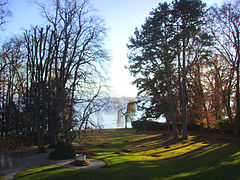Evangelische Akademie Tutzing
History
The Evangelische Akademie Tutzing was founded in 1947 in Tutzing, Bavaria, as Evangelisches Heimkehrer- und Freizeitheim. It was first an academy for doctors. Gerhard Hildmann, a theologian, was the director from 1948 to 1967. The bishop, Hans Meiser, coordinated the acquisition of Schloss Tutzing in 1949.
After World War II, politicians met at the academy to discuss the future of German democracy. They identified actions to be taken, which were later realized. Egon Bahr spoke on 15 July 1963 about "change through rapprochement", which influenced the relationship of chancellor Willy Brandt to the German Democratic Republic, resulting in the Ostpolitik.
Conferences at the academy initiated changes in politics, social sciences, religion, arts and culture. Topics have included the future of the European Union the integration of its countries, and concepts for the energy industry.
Buildings and park
The Baroque main building was built from 1693 to 1696. It was rebuilt by Thomas Ganseck from 1802 to 1816 for Count Friedrich Joseph von Vieregg. The additional Kavaliersbau was built in the 19th century. A separate hall was erected in 1802 as a Gartenmenagerie. It was made a Palmenhaus (palm house) in 1870, and remodeled in 1922 to a banquet hall with an Italian-style ceiling. The conference hall was built in 1959 by Olaf Andreas Gulbransson as a round auditorium with seating in a circular arrangement. The park was created in 1840 as an English landscape garden and was expanded upon in 1870 by Carl von Effner. In 1980, Hans-Busso von Busse added a restaurant in wood and glass which recalls the architecture of the Palmenhaus.
Literature
- Klaus-Jürgen Roepke (ed.): Schloss und Akademie Tutzing. Munich 1986.
- Udo Hahn: Schloss und Evangelische Akademie Tutzing. (In: Großer Kunstführer 280), Schnell & Steiner, Regensburg 2014.
Gallery
-
Entrance
-
Inner courtyard
-
Inner courtyard of a side building
-
A salon
-
View from the main building to the lake
References
- ^ Steinmeier, Frank-Walter (2016). "Speech by Foreign Minister Steinmeier at the award ceremony for the 2016 Tolerance Prize of the Evangelische Akademie Tutzing (Protestant Academy of Tutzing)". Auswärtiges Amt. Retrieved 5 November 2016.
- ^ König, Jürgen. "Evangelische Akademie Tutzing" (in German). Historisches Lexikon Bayerns. Retrieved 5 November 2016.
- ^ "Egon Bahr, "Wandel durch Annäherung". Rede in der Evangelischen Akademie Tutzing (Tutzinger Rede), 15. Juli 1963" (in German). 1000dokumente.de. Retrieved 5 November 2016.
- ^ "FWD: Europe – The young generation" (in German). Akademie. Retrieved 5 November 2016.
- ^ "Tutzing – Baudenkmäler" (PDF) (in German). Bayerisches Landesamt für Denkmalpflege. 6 October 2016. pp. 8–9. Retrieved 17 November 2016.
- ^ "Der historische Ort" (in German). Schloss Tutzing. Retrieved 17 November 2016.
External links
- Official website
- Evangelische Akademie Tutzing Evangelische Akademien in Deutschland
- Evangelische Akademie Tutzing / 63 Veranstaltungen im Jahresprogramm Archived 2016-11-06 at the Wayback Machine bayern-evangelisch.de 2016
- Evangelische Akademie Tutzing schloss-tutzing.de
- Tutzing Archived 2016-11-06 at the Wayback Machine 2016 Tag des offenen Denkmals




